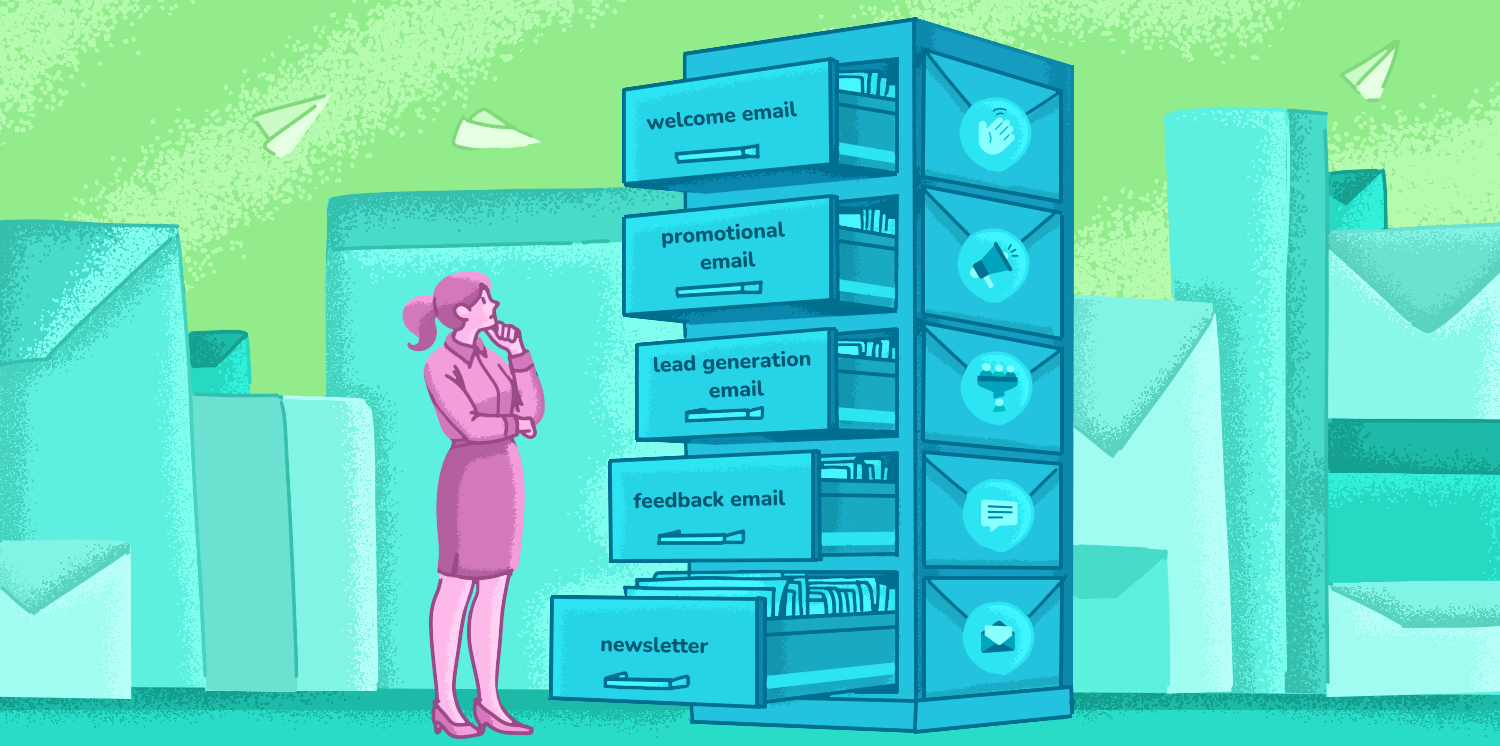In the daily hustle of running a business, you’re knee-deep in emails and tasks that grow like weeds. You dream of cutting the endless cycle of typing, sending, and scheduling emails. Meanwhile, automation sounds too cold or distant and lacks a personal touch. Sounds familiar?
Let us ease your fears.
This guide will show how automated email workflows can become your partner in better engagement and more innovative marketing.
Outline
What is an email workflow?
An email workflow is a sequence of scheduled emails automatically triggered by the recipient’s actions or preferences. Email automation workflows aim to fulfill specific goals, such as welcoming new users (onboarding) or facilitating a purchase.
Automated email marketing workflows help turn leads into customers faster and favor repeat purchases — all with a friendly, engaging approach.
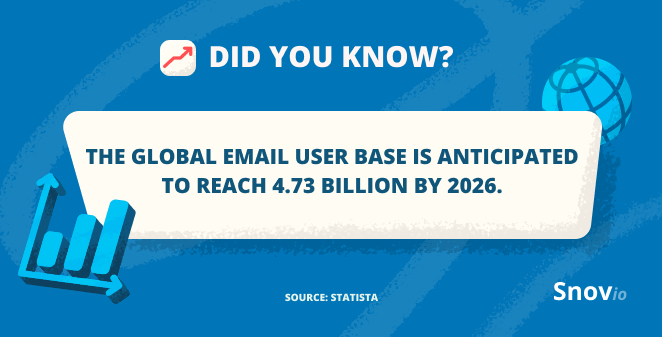
|
👀 Pro tip! With Snov.io’s LinkedIn Automation Tool, you can set up omnichannel email automation workflows and add LinkedIn actions to your outreach!
|
With such a toolset, there’s no need to worry that your emails might lose their personal touch.
Why do you need to implement email automation workflows?
Email automation workflows boost the effectiveness of your interactions with customers, making them more engaging. Moreover, email automation saves your team significant time and effort, increasing their job satisfaction. For businesses, this means helping talented professionals perform their work to the best of their abilities.
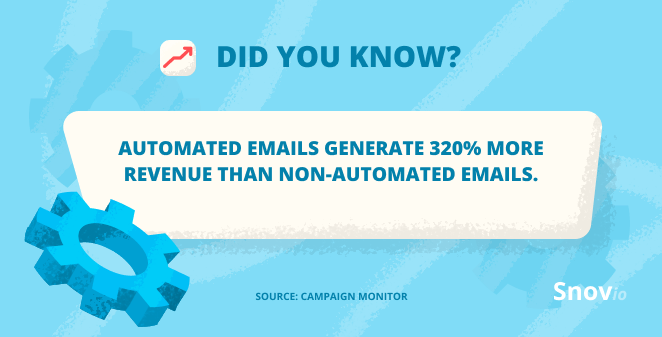
Let’s dive deeper into the perks of email automation workflows.
What are the benefits of email marketing workflows?
Email marketing automation software can streamline processes and provide valuable insights to enhance your campaigns.
- Streamlined work process
- Scalability
- Improved customer experience
- Reduced risk of error
- Analytics and growth insights
Streamlined work process
With email automation, you can set up a system that manages repetitive tasks independently. Email workflows help you boost productivity and efficiency, freeing up your time for creative and strategic tasks at hand.
|
🕵️Case study A SaaS company qualified in project management tools noticed that its marketing team spends too much time crafting and sending product-related email campaigns to the subscriber base. This manual process is time-intensive and limits the team’s ability to engage in more creative and important projects. The company implements automated workflows, so email sending is automatically triggered by user behavior and subscription preferences. For example, when a user signs up for a webinar, they automatically receive a series of follow-up emails. The first one has additional resources on the topic. Another one reminds me of the webinar a day before the event. The final email provides a webinar recording afterward. As a result, the team can now spend more time analyzing the results of their marketing strategy. Such insights help them refine their approach and develop new campaigns that optimize user engagement and conversion rates. |
Scalability
As your business expands, it’s crucial to keep up with the growing demands without dropping the ball on personal connections. Email workflows excel in this area by scaling your marketing efforts without losing the personal touch. They handle large volumes of emails quickly and ensure your email marketing strategy and team keep up as you expand. Meanwhile, you don’t need to allocate more and more resources all the time.
|
🕵️Case study A tech startup develops mobile apps and regularly informs its users about new features, upcoming online events, and promotions. Usually, the company’s marketing team manually sends these updates after each app update, which happens once a month. As the number of app users grows, this task becomes cumbersome and prone to errors and delays. To streamline this process, the startup implements an automated email workflow. Now, when the developers set the date of the new release, the marketing team has the time to plan the next email campaign. They create personalized email copy with the help of AI tools, schedule the sending time, and monitor opens and clicks afterward. The email sequences are personalized based on the user’s previous interactions with the app. The transition to automated email marketing workflows ensures that communication remains consistent, timely, and error-free. This allows the startup to maintain a smooth process as its user base continues to expand. |
Improved customer experience
Email workflows help you tailor your messages to meet customers’ needs and preferences. These may include birthday greetings, special promotions based on previous purchases, timely updates about their transactions, etc.
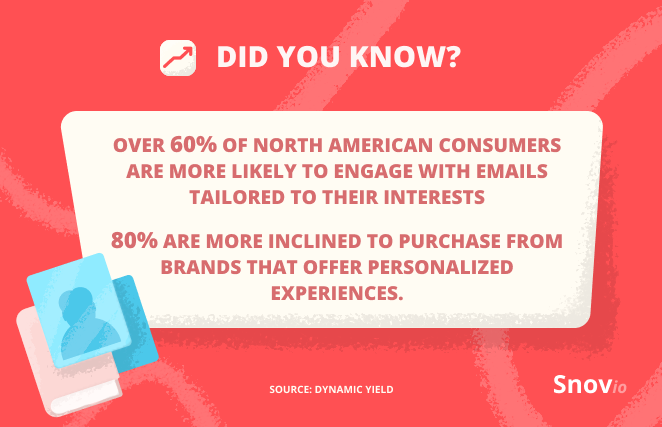
Personalized automated email workflows make your customers feel genuinely cared for and improve their overall experience with your brand
|
🕵️Case study A cloud storage service wants to enhance customer experience, so the managers implemented automated email workflows in their outreach campaigns. For instance, whenever a customer has a birthday, the automated system sends them an email with a personalized greeting. It includes a special discount on their current storage plan. Likewise, clients get a personalized plan upgrade email after using a significant amount of their storage capacity. It is tailored with relevant content and a promotional offer based on their usage patterns and previous purchases. Further, whenever a customer completes upgrading their plan or purchasing additional services, they immediately receive a personalized confirmation email. The latter is followed by a series of onboarding emails with tips on maximizing their new plan. These automated and customized email interactions significantly improve the user experience, leading to better retention rates. |

How To Calculate And Improve Your Customer Retention Rate
January 20 2024
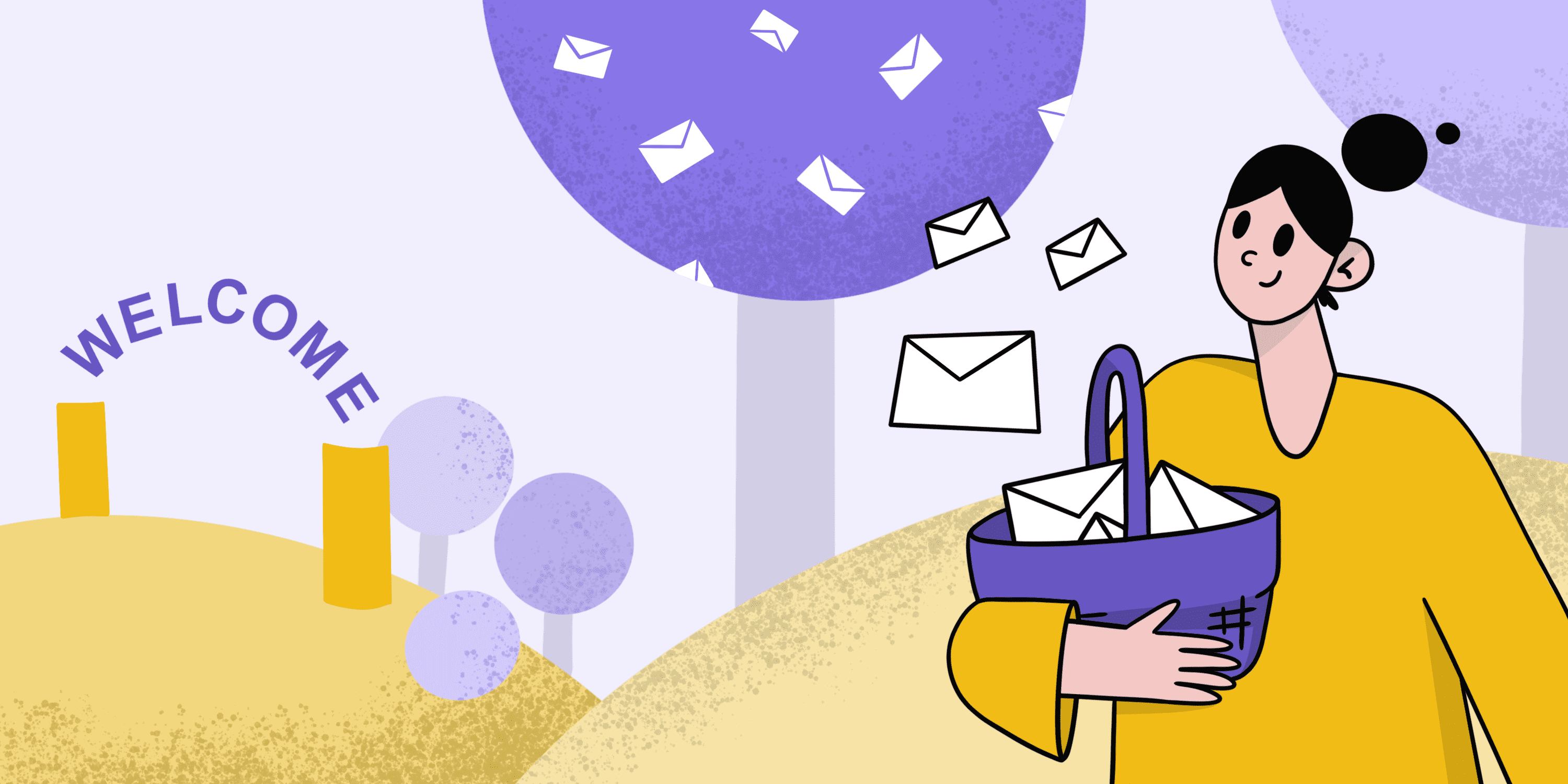
10 Welcome Email Templates That Grow Sales
June 25 2025
Reduced risk of error
Human error is inevitable, especially when tasks become repetitive. Automated email workflows help eliminate such mistakes by ensuring that every email you send is correct and consistent. By relying on email automation, you rely on the accuracy of communication and maintain your brand’s credibility.
|
🕵️Case study A digital marketing agency sends monthly newsletters to its clients. Initially, the process involved a team member manually compiling email addresses and sending out the newsletter. As a result, occasional mistakes occurred, such as misspelled email addresses, duplicate emails, or even missed recipients. To reduce these errors, the agency implemented an automated email workflow. Now, when a new client signs up for the newsletter, their email is automatically added to the distribution list. The newsletter content is pre-set and reviewed in a templated format, which minimizes errors. On a specified day each month, the system automatically sends the error-free newsletter to the entire list of subscribers. This helps the agency build smooth communication with the clients and reinforces trust and satisfaction with its services. |
Analytics and growth insights
Email automation offers insightful analytics for your campaigns. By analyzing how users react to your emails, you can become more compliant with email standards and improve overall email engagement. Finally, email automation workflows allow you to see how well your email marketing strategy aligns with your ideal customer profile.
All these insights help you improve your email marketing approach.
|
🕵️Case study A software development company regularly communicates with its clients through monthly progress reports and updates. Initially, the process required a project manager to manually compile updates, personalize emails, and an email marketing specialist to send them out. This approach was time-consuming, insufficient, and complicated. To address these challenges, the company has implemented an automated email workflow. This system has been integrated with the CRM to automatically generate and send personalized progress reports to clients. As a result, automated tracking revealed higher open and click-through rates, indicating increased client engagement. Analytics identified the most engaging content types for clients, allowing for more targeted and effective communication. Plus, automation significantly reduced the time and effort required for email building and sending. All this has enabled the company to make informed, data-driven decisions to improve its communication strategies and project management practices. |
|
🎁 Want to learn more about automating your sales? Join the FREE Udemy course and learn how to generate leads and sell more efficiently with Snov.io LinkedIn automation! |
Types and examples of email marketing automation workflows
Let’s review some other popular types of email workflows:
- Lead nurturing workflow
- Re-engagement workflow
- Post-purchase workflow
- Abandoned cart email workflow
- Event invitation workflow
Lead nurturing workflow
This one is designed to guide leads along the buyer’s journey by providing them with relevant and valuable content. Email marketing automation tools can help create and manage lead nurturing workflows, ensuring a seamless and efficient process.
These emails aim to build trust and credibility, gradually moving potential customers from the awareness to the decision-making stage. They include educational content, product comparisons, testimonials, etc., that inform leads about your solution and persuade them to buy it.
Take a look at the lead nurturing workflow automation example you can build and launch with Snov.io:
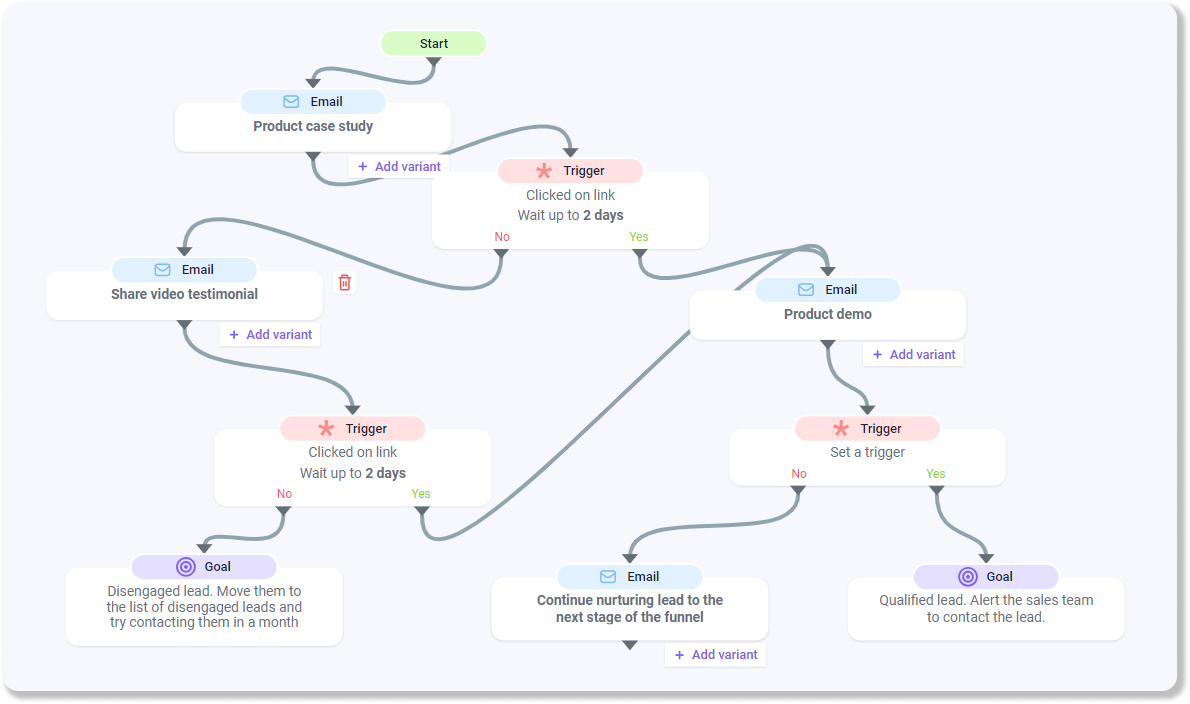
Re-engagement workflow
Re-engagement workflow targets subscribers who have become inactive or less responsive over time. The aim is to reignite interest by reminding subscribers of their missing benefits or offering special incentives to lure them back. Re-engagement automation workflows are a great way to cleanse your list and reawaken dormant relationships with new subscribers.
Here is a re-engagement workflow automation example you can build and launch with Snov.io:
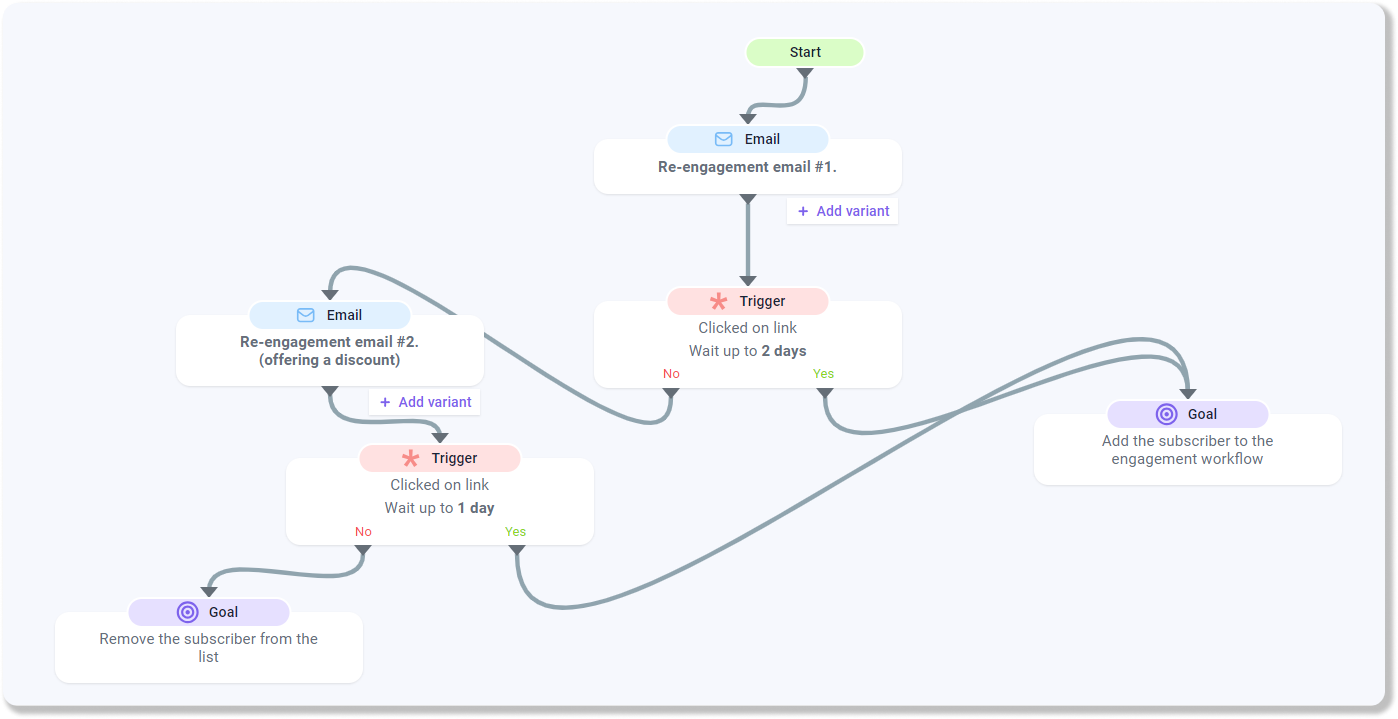
Post-purchase workflow
A post-purchase workflow assists customers at the after-sales stage, beginning with a purchase confirmation email. Normally, it should be focused on encouraging customers to continue engaging with you after the purchase.
For example, you can ask them to share their feedback about a sales rep’s work or product quality. Alternatively, you can request a referral and offer them a discount for the next purchase. The idea is to move customers slightly to the next workflow—cross-selling or upselling.
Here’s an example of a post-purchase email workflow:
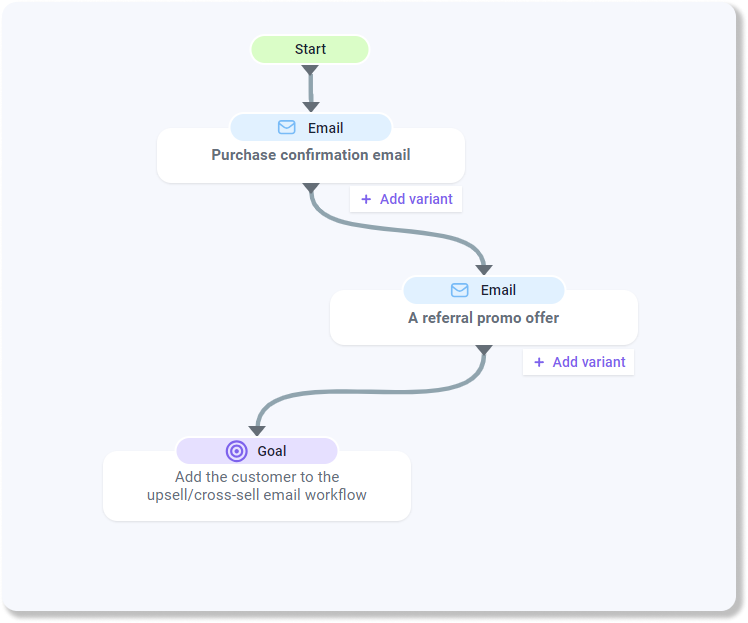
Abandoned cart email workflow
These workflows are triggered when a prospect adds items to their online shopping cart but doesn’t complete the purchase. These emails typically remind them of what they left behind. To encourage prospective customers to complete their transactions, you can offer them a discount or free shipping.
Take a look at the example of an abandoned cart workflow you can easily build with Snov.io:
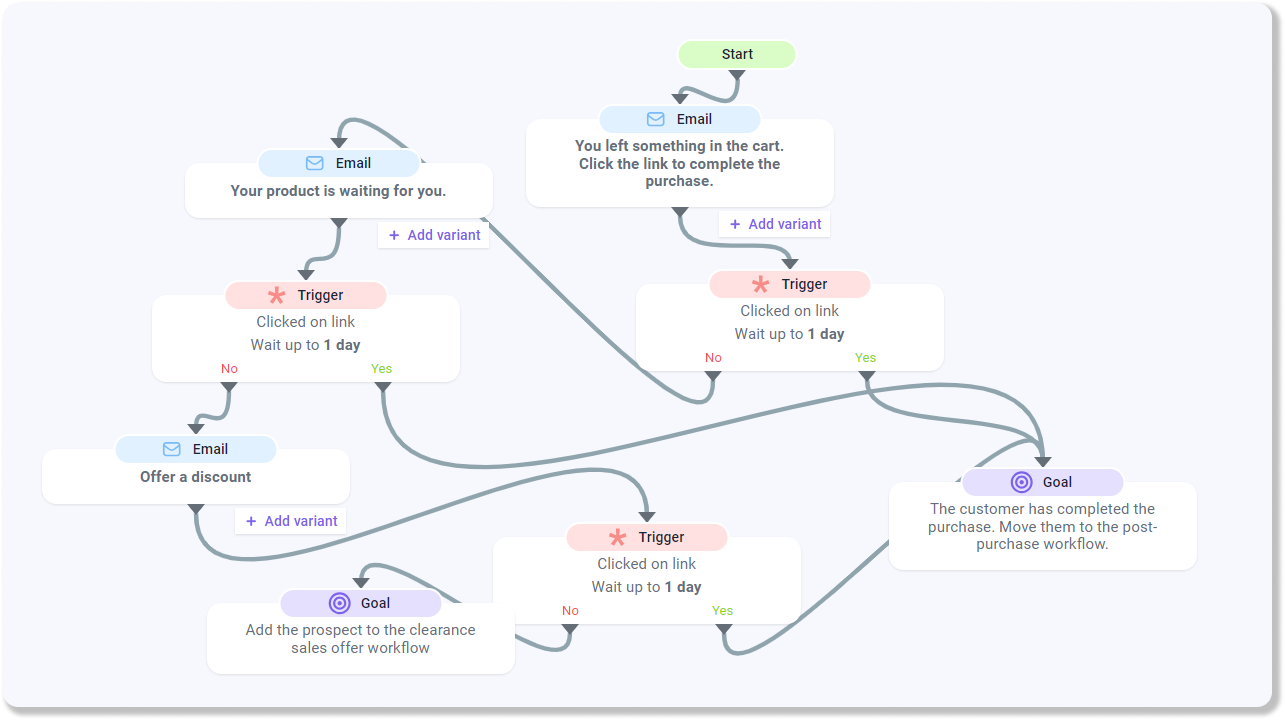
Event invitation workflow
Event invitation workflows are designed to increase attendance at events like webinars, workshops, or in-store promotions. They start with an invitation, followed by a series of reminders and teasers about what to expect. You commonly crown this email workflow with a follow-up email after the event to extend engagement or provide additional resources.
For instance, let’s look at the example of a webinar invitation workflow:
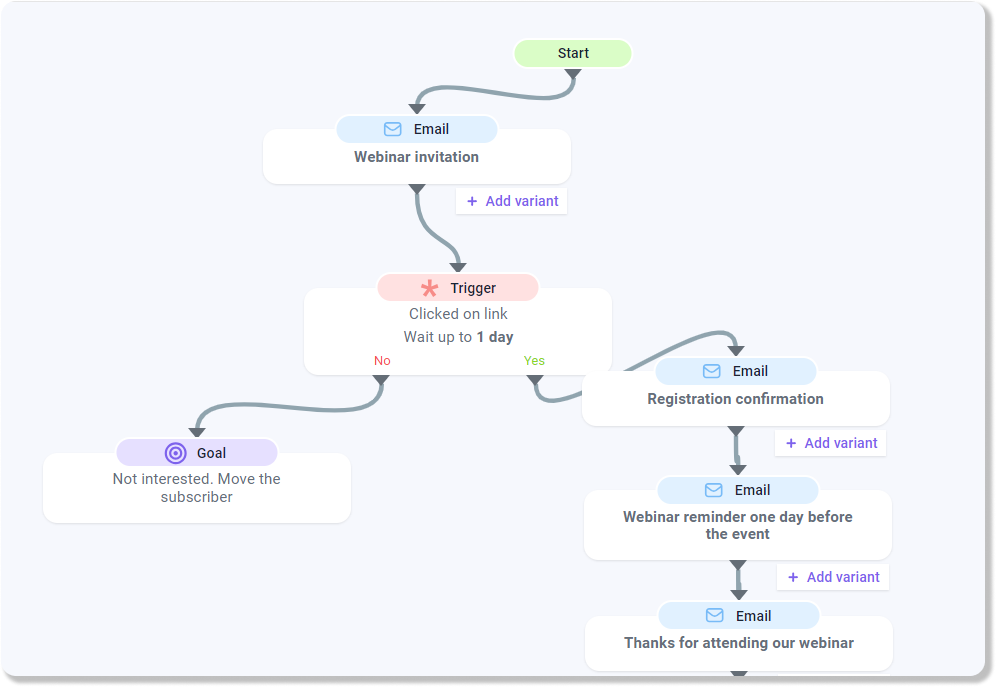
How to build automated email marketing workflows
We’ve reached the most exciting part of our story — how to implement automated email marketing workflows in your business. Wondering if it’s complicated or costly? Let’s break it down into manageable steps:
- Set goals
- Determine which part of the workflow you want to automate
- Select automation software
- Create the workflow and run a test
- Measure the results to move forward
1. Set goals
Start by identifying what you want to achieve with your email workflows. Setting clear objectives will guide your email marketing strategy, whether it’s increasing sales, improving customer engagement, or nurturing leads.
2. Determine which part of the workflow you want to automate
Review your current email processes and decide which parts are repetitive or time-consuming. Automating these areas can save you time and reduce errors, making your email marketing campaigns and efforts more efficient.
For example, if your business often sends educational emails to new leads, this process is ideal for automation. A software company should definitely automate its welcome and onboarding sequences to teach new users about its tech stack.
3. Select automation software
Choose email automation software that aligns with your business needs and budget. Overall, implementing automated email marketing workflows is not as complicated or costly as you might think. Popular platforms like Snov.io, HubSpot, and Salesforce are user-friendly, offering drag-and-drop editors and pre-built templates to simplify the setup.
A good bonus is if your workflow automation tool boasts many integration capabilities, is scalable, and provides great customer support.
|
DID YOU KNOW?
|
4. Create the workflow and run a test
Design your workflow by mapping out the sequence of emails triggered by user actions or time intervals. Once set up, run a test to ensure everything works as planned. This is crucial for spotting any issues before going live.
For example, Snov.io allows users to A/B test subject lines and emails to learn which gets the most opens and which content drives engagement and sales.
5. Measure the results to move forward
After your workflow is up and running, monitor its performance. Analyze open rates, click-through rates (CTR), and conversion rates to understand their impact. Use this data to tweak and improve your workflow for better results over time.
Many email automation workflow tools have an in-built email tracking mechanism. You can also try more advanced analytics tools, such as Google Analytics.
Key takeaways
Integrating automated email workflows can be a game-changer for your small business. It can bring sharper engagement, stronger customer loyalty, and smoother operations. With email marketing automation, you’re setting up your business for increased sales and happier office days.
And if you ever worry email automation workflows are hard nuts to crack, Snov.io has a solid toolset in place. Let it be an intelligent investment for your email marketing boost. It’s high time your team gave themselves more room to shine and enjoy their work!
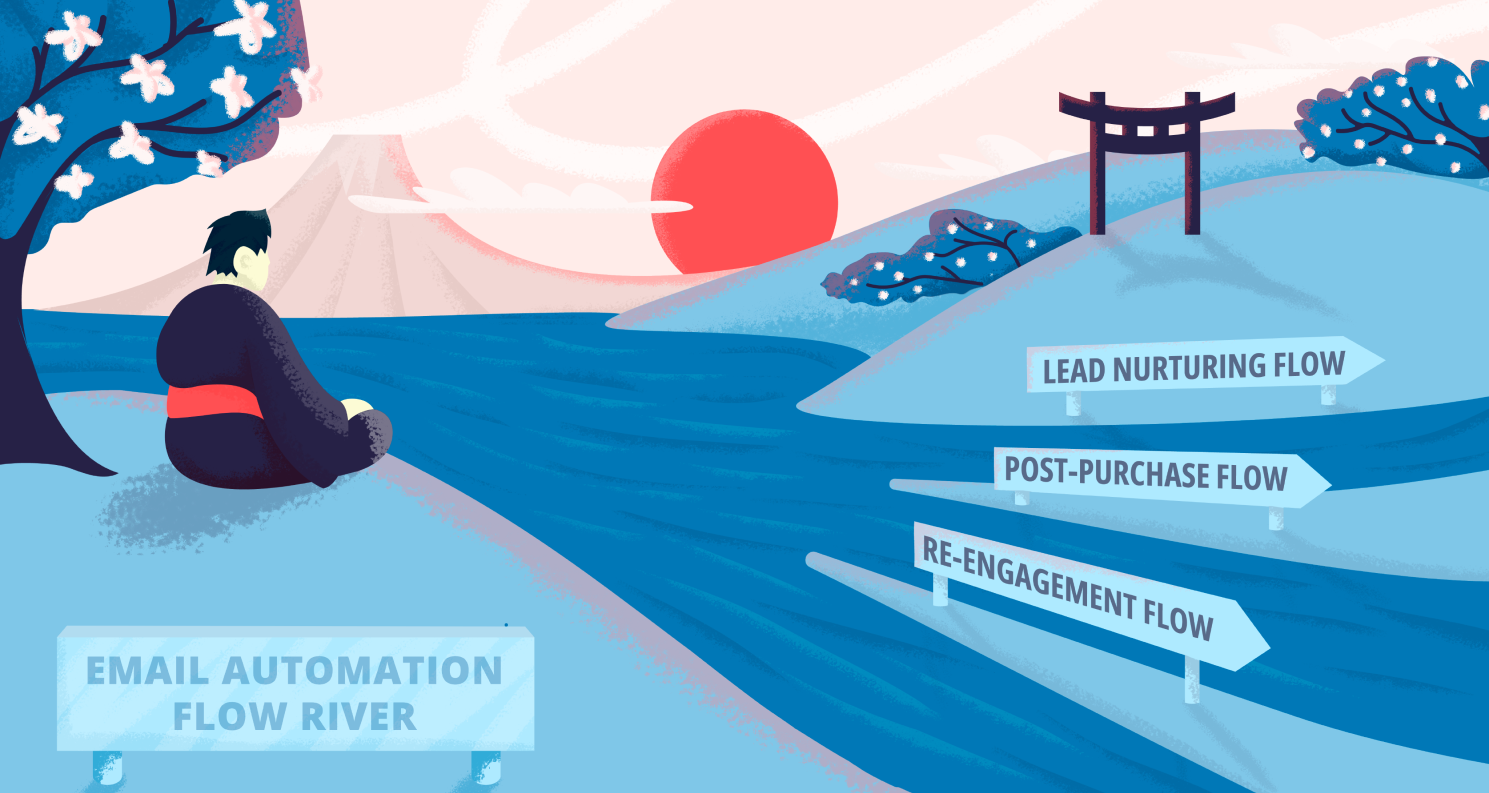
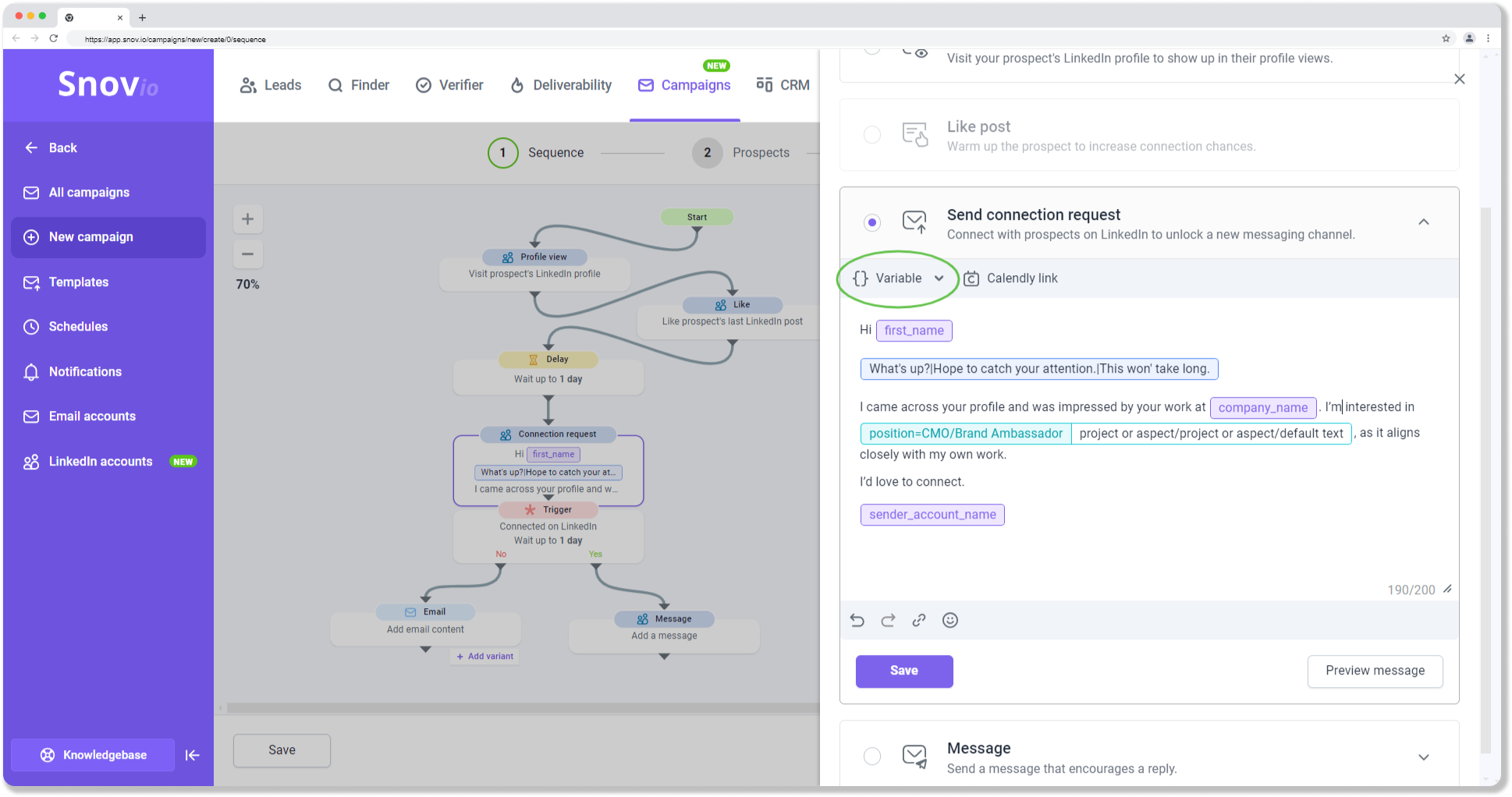

 In the Summer of 2024, G2, one of the world’s largest software marketplaces, awarded
In the Summer of 2024, G2, one of the world’s largest software marketplaces, awarded 
